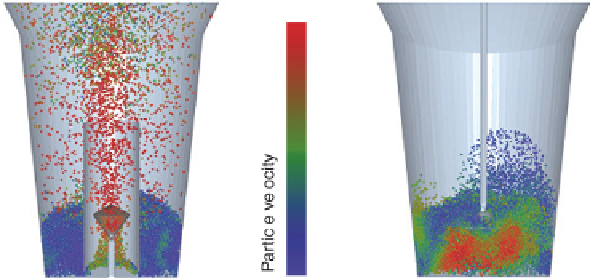Information Technology Reference
In-Depth Information
Particle positions and velocity distributions inside:
(a) Wurster-coater: and (b) top-spray granulator, at the
simulation time t = 1.4 s (reprinted from Fries et al.,
2011; with permission from Elsevier)
Figure 7.16
then in the Wurster granulator. In order to investigate the effects of
particle and fl uid dynamics on particle wetting, the residence time of the
particles inside the spray zone was monitored. The Wurster granulator
was characterized by a narrow residence time distribution, resulting in
homogeneous particle wetting, while the top-spray granulator was
characterized by wide residence time distribution, due to the irregular
particle motion. It was shown that the velocity of the air injected via the
nozzle and position of the draft tube in the Wurster granulator can affect
fl uid and particle dynamics.
Chua et al. (2011) used theoretical analysis coupled with CFD
simulations to predict granule-granule and droplet-granule collision
rates of fl uidized bed melt granulation in a top-spray granulator. CFD
simulations provided interesting information about hydrodynamics in
the region around the spray nozzle. Higher granular temperature was
observed around the spray nozzle, indicating higher collision rates in this
region (Figure 7.17). Due to the atomizing air fl ow effects, granules
within the spray zone are rapidly pushed towards the bottom, resulting
in solids concentrated at the walls. The range of granule-granule and
droplet-granule collision rates was determined, and droplet-granule
collision was found to be much faster, but slowed exponentially when
moving away from the spray nozzle. The authors concluded that results
of this study, together with time scale analysis of droplet spreading and
solidifi cation, may improve understanding of the events occurring during























Search WWH ::

Custom Search